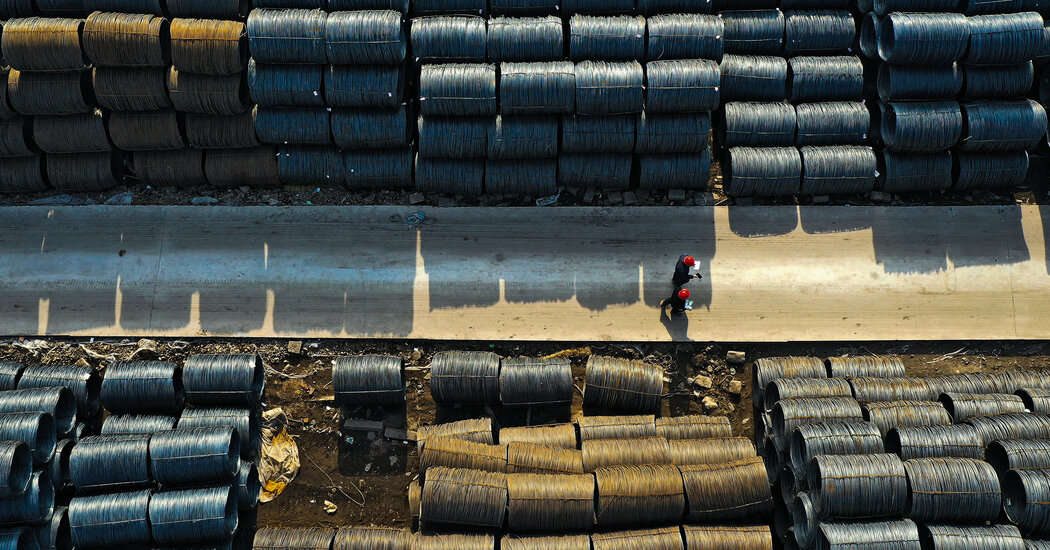
Trump’s Tariffs on Steel and Aluminum Re-Up Contentious First-Term Policies
- Economy
- February 10, 2025
- No Comment
- 98
President Trump is poised to move forward with sweeping tariffs on foreign steel and aluminum on Monday, re-upping a policy from his first term that pleased domestic metal makers, but hurt other American industries and ignited trade wars with allies on multiple fronts.
The 25 percent tariffs that the president said he would impose on foreign steel and aluminum will be welcomed by domestic steelmakers, who argue they are struggling to compete against cheap foreign metals. As they did during Mr. Trump’s first term, U.S. metal makers have been lobbying the administration for protection, and Trump officials agree that a strong domestic metal sector is essential for U.S. national security.
But the tariffs will invite plenty of controversy. They are likely to rankle America’s allies, like Canada and Mexico, who supply the bulk of U.S. metal imports. And they could incite retaliation on U.S. exports, as well as pushback from American industries that use metals to make cars, food packaging and other products. Those sectors will face significantly higher prices after the tariffs go into effect.
That’s what happened in Mr. Trump’s first term, when he slapped 25 percent tariffs on foreign steel and aluminum. While he and President Biden eventually ended up rolling back those tariffs on most major metal suppliers, they were often replaced with other trade barriers, like quotas. Studies have shown that while the measures helped U.S. metal makers, they ended up hurting the broader economy, because they raised prices for so many other industries.
Mr. Trump seemed to disregard that history on Sunday. As he flew to the Super Bowl aboard Air Force One, he said he planned to impose a 25 percent tariff on steel and aluminum on all imports. He also said that he would move forward with so-called reciprocal tariffs, which would raise certain U.S. tariff rates to match those of foreign countries, later this week.
“Very simply, if they charge us, we charge them,” he said.
On his first day in office, the president commissioned a variety of detailed reports on nearly two dozen trade measures, which were meant to underpin his coming trade actions. But he has not waited for the results.
In his three weeks in office, the president has already threatened more tariffs globally than he did in his entire first term, when he ended up imposing tariffs on foreign solar panels, washing machines, metals and more than $300 billion of products from China.
Since taking office, Mr. Trump has imposed an additional 10 percent tariff on all products from China, and came within hours of imposing sweeping tariffs on Canada and Mexico that would have brought U.S. tariff rates to a level not seen since the 1940s. Together, those moves would have affected more than $1.3 trillion of goods.
Mr. Trump has also said in recent days that he planned to impose tariffs on Europe, Taiwan and other governments, as well as on a variety of critical industries like copper, steel, aluminum, pharmaceuticals and semiconductors.
The president has imposed global tariffs on steel and aluminum before. In his first term, the president levied tariffs on foreign steel and aluminum globally, angering allies like Mexico, Canada and the European Union.
Mr. Trump reached agreements with Australia, South Korea and Brazil, and rolled back some of those barriers on Canada and Mexico when they signed a revised trade agreement with the United States. The Biden administration later reached agreements with the European Union, the United Kingdom and Japan to roll back some of their trade restrictions.
The largest supplier of steel to the United States in 2024 was Canada, followed by Brazil, Mexico, South Korea and Vietnam, according to the American Iron and Steel Institute. Canada is also a major supplier of aluminum to the United States, followed distantly by the United Arab Emirates, Russia and China.
The United States imports very little steel or aluminum directly from China, since Chinese exports have long been blocked by a variety of anti-dumping and subsidy tariffs. But some argue that China’s excess steel production is still flooding other markets and pushing down global prices, leaving U.S. metal makers at a disadvantage in other markets.
The protections put in place for the domestic steel industry have also not been sufficient to secure the fortunes of U.S. Steel, the iconic Pennsylvania company that has struggled financially and had agreed to be acquired by Nippon Steel of Japan. That merger was blocked by President Biden, who said he wanted to U.S. Steel to remain an American company.
American steelmakers welcomed the tariffs. In a statement Sunday, Kevin Dempsey, the president of the American Iron and Steel Institute, said that the group welcomed Mr. Trump’s “continued commitment to a strong American steel industry, which is essential to America’s national security and economic prosperity.”
Nazak Nikakhtar, a partner at the law firm Wiley Rein and a former official in the first Trump administration, said that the president was again “making good on his promise to impose tariffs globally and to increase tariffs on steel and aluminum imports, given their criticality to national security.”
She said that the new tariffs would be added to existing tariffs on steel and aluminum, and it remained to be seen if there would be any exceptions, for example for Canada and Mexico.
The fact that the United States has imposed a 25 percent metal tariff before means economists have extensive data on how they have affected U.S. industries.
A study by the nonpartisan International Trade Commission, for example, found that the steel and aluminum tariffs increased the price of imports, and encouraged consumers of steel and aluminum to buy more American metals as opposed to foreign ones. The increase in demand further pushed up metal prices, and allowed American metal makers to expand their production, resulting in $2.25 billion of additional U.S. production of steel and aluminum in 2021.
But the policy had an important downside, the study shows. The higher prices of steel and aluminum translated into higher costs for downstream industries that buy those metals to make other things. The higher costs were particularly painful for companies making industrial machinery, car parts and hand tools.
Altogether, industries that consume steel and aluminum saw their production shrink by $3.48 billion as a result of the tariffs — more than offsetting what the steel and aluminum makers had gained.
Some in the U.S. metal industries say that the levies have not gone far enough. They argue that metal imports from other countries, like Mexico, started to surge shortly after tariffs were rolled back as part of the U.S.-Mexico-Canada Agreement signed in 2020.
Zach Mottl, the chairman of the Coalition for Prosperous America, which supports the metal tariffs, said these trends were evidence that tariffs needed to be expanded, not reduced, to protect downstream industries in the United States as well.
“It’s important to create a market for all the inputs in the supply chain and then the final product, too,” he said.
Mr. Mottl runs Atlas Tool Works, a precision manufacturer near Chicago, which buys steel and aluminum to make products for the aerospace, medical and telecom industries, among others. He said that he initially saw a spike in steel and aluminum prices from the tariffs, but then prices fell back and new sources of supply cropped up. “The tariffs did what they were supposed to,” he said.
Chad Bown, a senior fellow at the Peterson Institute for International Economics, said Mr. Trump’s move raised many questions about whether the administration would ultimately exclude certain countries or industries from the measure. “Does the president want to negotiate deals, just like he did back then with South Korea, Brazil and Argentina? If they are targeted, will China, Mexico, Canada, and the European Union retaliate again with tariffs against American exports?”
“This makes things feel like 2018 all over again,” he said.
Other industries are also concerned about being caught in the crossfire, and targeted with tariffs as other countries retaliate. China imposed retaliatory tariffs on U.S. exports on Monday in response to the tariffs Mr. Trump put on China last week because of its role in the fentanyl trade. Mexico, Canada and the European Union have all drawn up lists of American products they could strike with their own levies in response to U.S. measures.
In response to the metal tariffs, for example, the European Union imposed a 25 percent tariff on American whiskey. The American and European governments negotiated a deal to temporarily suspend those tariffs, but it is set to expire soon. If another agreement is not reached, the European Union will double that tariff to 50 percent on April 1.
Chris Swonger, the chief executive of the Distilled Spirits Council of the United States, which represents the whiskey industry, said in a statement that the tariff would have a “catastrophic outcome” for 3,000 small distilleries across the United States.
“We are urging that the U.S. and E.U. move swiftly to find a resolution,” Mr. Swonger said. “Our great American whiskey industry is at stake.”
#Trumps #Tariffs #Steel #Aluminum #ReUp #Contentious #FirstTerm #Policies









